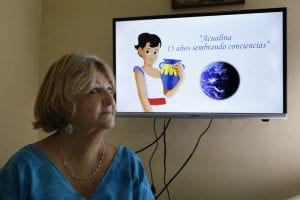Throughout human history women have played and continue to play a major role when carrying for the Earth’s environment. Women in particular are often the chief resource producers for their families in many parts of the world. As a result, these women become deeply dependent on natural resources which provide food, fuel, and shelter. Unfortunately, centuries of gender division between labor, land, and other resources has created an unequal and disproportionate affect on women. Authors Kari Norgaard and Richard York argue within their article Gender Equality and State Environmentalism, that “in an unequal society, the impacts of environmental degradation fall disproportionately on the least powerful…the gendered division of society provides women with unique firsthand experiences of environmental problems” (Norgaard & York 507). Therefore, it is no surprise that women have become the environments front line defenders.
Currently, studies have confirmed that woman tend to be more environmentally progressive within their communities in comparison to men cross-nationally. In nations like Germany and Russia “girls had higher levels of environmental awareness than boys; in Australia, girls exhibited greater environmental responsibility than did boys when socioeconomic levels were held constant” (Norgaard & York 509). Thus, within their article authors Norgaard and York were interested in analyze the benefits associated with the inclusion of women as equal members of society. They specifically chose to focus on the relationship between the number of women in Parliament and state environmentalism. The results of the analysis clearly suggested a positive correlation associated with women actively participating as citizens, voters, policy makers (a.k.a members of Parliament), and social movement participants and the development of state environmentalism. However, a 1990 UN Commission on the Status of Women estimated that in order for women to truly influence key outcomes and be taken seriously in state policy, a threshold of 30% of women in Parliament was required (Norgaard & York 514).
 While the United States acts as one of the worlds largest powers, it still lags well behind when it comes to female representation. Ranked as 75th on the list, the U.S. does not reach the global average of 24.1% of lower house seats won by women (World Economic Forum). On the other hand, countries like Rwanda and Cuba hold the highest rankings for female representation in parliament. Since the new constitution was passed in 2003 decreeing that 30% of parliamentary seats be reserved for women in Rwanda, the country has been classified as incredibly clean, green and safe with many referring to it as the new Singapore of Africa. The village Rubaya located in the hills of northern Rwanda has played a major role in the country’s first “Green Village” intuitive. As a result, forty-three families have seen their food security improve (UN Environment Program). The key to the project’s success has been to focus on empowering the community, in particular the women. Thus, by empowering the local women the community as a whole has benefited tremendously.
While the United States acts as one of the worlds largest powers, it still lags well behind when it comes to female representation. Ranked as 75th on the list, the U.S. does not reach the global average of 24.1% of lower house seats won by women (World Economic Forum). On the other hand, countries like Rwanda and Cuba hold the highest rankings for female representation in parliament. Since the new constitution was passed in 2003 decreeing that 30% of parliamentary seats be reserved for women in Rwanda, the country has been classified as incredibly clean, green and safe with many referring to it as the new Singapore of Africa. The village Rubaya located in the hills of northern Rwanda has played a major role in the country’s first “Green Village” intuitive. As a result, forty-three families have seen their food security improve (UN Environment Program). The key to the project’s success has been to focus on empowering the community, in particular the women. Thus, by empowering the local women the community as a whole has benefited tremendously.
Cuba has some of the best preserved land and waters in the Caribbean, even being referred to as the “jewel of the Caribbean.” According to official reports Cuban women in politics currently make up “nine of the 25 cabinet ministers and 14 of the 31 members of the state council are women, as are 299 of the 612 deputies of the National Assembly of People’s Power” (Grogg) . While female participation in Cuban society has increased, they do continue to be more vulnerable to the impact of climate change. In particular, the majority of Cuban women often assume the domestic role acting as heads of the households while suffering greater tensions in the face of shortages during extreme events. However, women like marine biologist Angela Corvea are leading the way in environmental education initiatives. Corvea is the creator of the little cartoon philosopher dressed in an Ancient Greek tunic named Acualina. The little philosopher broadcasts her teachings, advice, issues warnings, and provides guidelines on how to reduce risks to the environment on TV and through other means, such as stickers and books.
. While female participation in Cuban society has increased, they do continue to be more vulnerable to the impact of climate change. In particular, the majority of Cuban women often assume the domestic role acting as heads of the households while suffering greater tensions in the face of shortages during extreme events. However, women like marine biologist Angela Corvea are leading the way in environmental education initiatives. Corvea is the creator of the little cartoon philosopher dressed in an Ancient Greek tunic named Acualina. The little philosopher broadcasts her teachings, advice, issues warnings, and provides guidelines on how to reduce risks to the environment on TV and through other means, such as stickers and books.
While women continue to produce between 60 and 80 percent of food in developing countries they officially only own 2 percent of land worldwide (Global Women’s Issues). However, with their integration into political society women are able to not only empower themselves, but also our environment. Which in the end benefits us all.
Sources:
https://pages.uoregon.edu/norgaard/pdf/Gender-Equality-Norgaard-York-2005.pdf
https://www.weforum.org/agenda/2019/02/chart-of-the-day-these-countries-have-the-most-women-in-parliament/
https://www.huffpost.com/entry/rwanda-a-success-story-of-women-empowerment_b_5a4f1d87e4b0ee59d41c09ad
https://www.unenvironment.org/news-and-stories/story/women-take-lead-rwandas-first-green-village
https://www.realchangenews.org/2018/10/31/cuban-women-vulnerable-climate-change-forefront-struggle

Hi Angela, I wanted to say that I really enjoyed reading your post this week and wanted to talk about a few points that you made. First I wanted to talk about this quote from your post, “Currently, studies have confirmed that woman tends to be more environmentally progressive within their communities in comparison to men cross-nationally. In nations like Germany and Russia “girls had higher levels of environmental awareness than boys; in Australia, girls exhibited greater environmental responsibility than did boys when socioeconomic levels were held constant” (Norgaard & York 509). ” I do believe this to be true because women by nature are more nurturing and caring for others and seemingly, the environment. So this makes sense that biologically women would be the ones who are more passionate about making changes to benefit our environment. I also liked how you included some statistics about female representation in the United States, stating, “While the United States acts as one of the world’s largest powers, it still lags well behind when it comes to female representation. Ranked as 75th on the list, the U.S. does not reach the global average of 24.1% of lower house seats won by women (World Economic Forum)”. This statistic kind of solidifies your point you make that when women are placed in positions of power in the government, the environment flourishes and becomes, “incredibly clean, green and safe”. It also shows how much good having diversity really does in the government for our everyday life when done correctly. Overall, great post this week and I look forward to reading more!
Hi Angela!
I want to say, the introduction to all your blogs are so well written and introduce what you will be talking about for the week so perfectly. In mentioning how women are often put out to save the environment in times of trouble I cannot help but to think about women in the global south. From reading those articles we now know that women in the global south are the ones who are responsible for gathering water for their families, providing food, caring for their families in all other ways. Not to mention women are natural born nurturers and some could argue that’s why we were put on this Earth. I believe women are much more than that of course but, in this case,, it could support the ideas behind the thesis presented by Norgaard and York that when women are given a stance in politics, more environmental policies are put into order. The statistic you mentioned about women being taken seriously in policies is so sad. In their study, Norgaard and York were able to provide statistics showing the relationship between gender equality and state environmentalism in different nations. The nations that gave women a chance and gave them the benefit to do what they were born to do showed significantly more state environment policies. Norgaard and York provided several examples of woman showing more interest in saving the environment and being more aware of what is going on in the environment than males. I also want to bring up what I am sure we all heard at one point and that being when Trump said climate change wasn’t real. That’s a male’s opinion on the environment. Compared to Greta Thunberg for instance, a young girl who advocates for climate change every single say of her life. Great work on your blog this week! Everything was so well said.
Hi Angela!
First I would love to say your blog on this is my favorite and really helped me understand the reading a lot better. When you state this “While the United States acts as one of the worlds largest powers, it still lags well behind when it comes to female representation. Ranked as 75th on the list, the U.S. does not reach the global average of 24.1% of lower house seats won by women (World Economic Forum).” I hadn’t yet researched that, when I did the reading I skimmed due to the fact I couldn’t really understand it, so I don’t know if this was something you researched on your own or received from the reading. BUT I ABSOLUTELY did not know about the US and seeing the numbers and knowing that other places reach at least 30% in parliament and we aren’t one of those countries says a lot. Questions automatically popped in my head and I wondered if a woman was in power how would this country develop. Woman understand the environment better to me, understand children, understand a struggle. So I believe they will impact this country regardless of their agenda. It’s sad that sometimes because we are women we are considered to be soft, mellow, calm, cool, and collective. We also are referred to as submissive and last but not least weak. So our judgement is alway impaired due to something they say. They blame our hormones and periods which is ignorant. I hope one day that a woman will run this country.
xx Gossip Girl